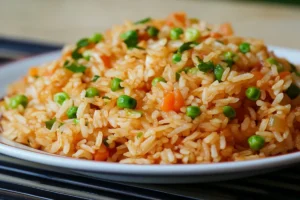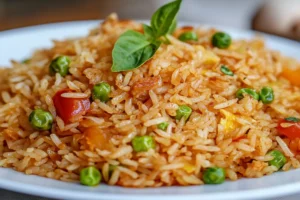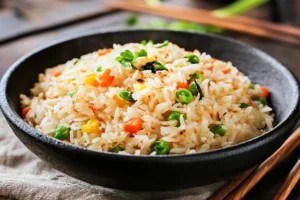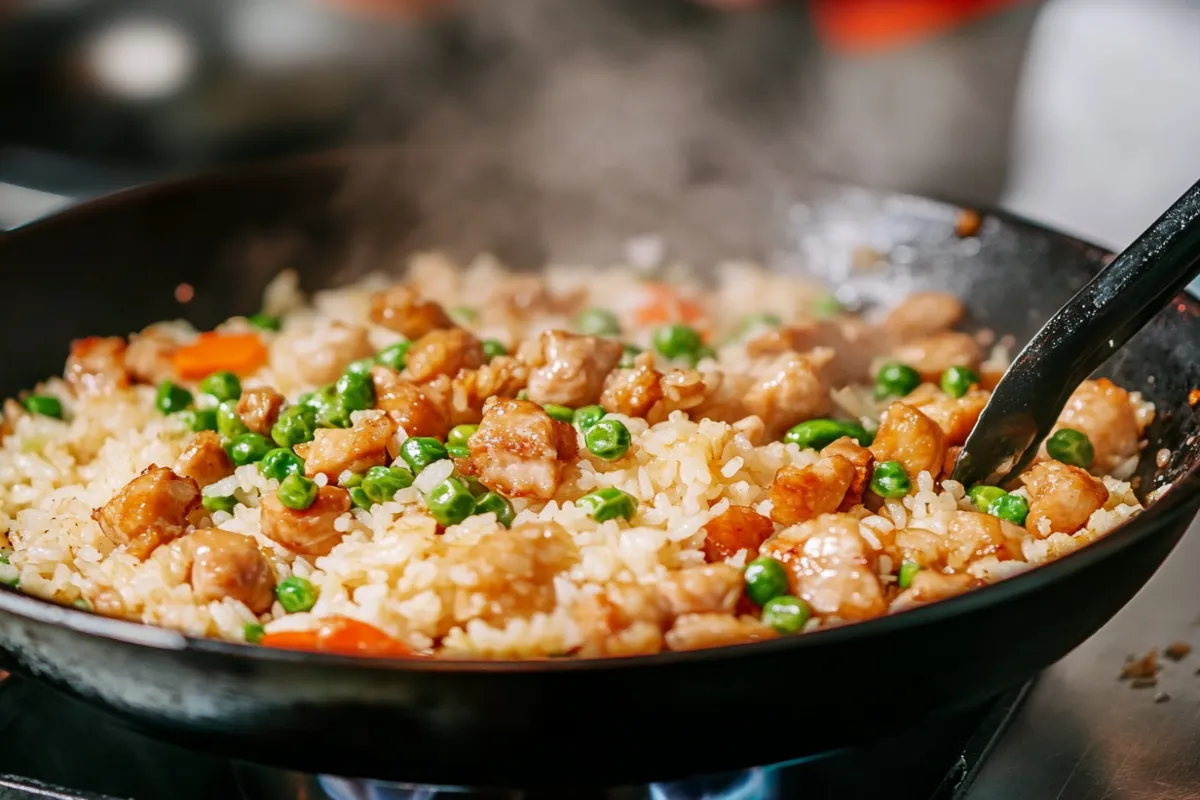Fried rice is one of the most popular and versatile dishes enjoyed worldwide. Whether you’re making it at home or ordering takeout, the key to elevating its flavor lies in balancing ingredients, applying the right techniques, and understanding the secrets behind that restaurant-quality taste. So, what makes fried rice taste better?
In this detailed guide, we’ll explore how specific ingredients, cooking methods, and tips can help you improve your fried rice, making it taste more like your favorite restaurant’s version. From using the right sauces to mastering high-heat cooking, every detail plays a part in the final result.
Essential Flavor-Enhancing Ingredients for Fried Rice
The foundation of any delicious fried rice is its ingredients. While rice is the star, the sauces and seasonings you use are just as crucial.
- Soy Sauce: This staple of Asian cooking provides the base layer of umami and saltiness. Be mindful not to overuse it—just a few teaspoons can be enough to flavor the entire dish. Using low-sodium soy sauce can help control the salt levels while still imparting deep flavor.
- Oyster Sauce: Oyster sauce adds a subtle sweetness and depth of flavor that soy sauce alone can’t provide. Its thick texture also helps coat the rice, giving it a richer taste. Learn more about what gives fried rice its flavor and how oyster sauce plays a role.
- Fish Sauce: For an extra boost of umami, fish sauce is a game-changer. Its concentrated flavor adds complexity to your fried rice, though you’ll want to use it sparingly, as it’s potent.
- Sesame Oil: Toasted sesame oil should be added at the end of the cooking process. Its nutty aroma elevates the dish with just a small drizzle. Used as a finishing oil, it imparts a rich, authentic flavor.
By combining these key ingredients in the right proportions, you can ensure your fried rice packs a flavorful punch. Check out easy fried rice recipes for inspiration on how to mix and match these sauces.
How to Use Aromatics for a Boost of Flavor

Aromatics like garlic and ginger are vital to boosting the flavor of your fried rice. These ingredients release their fragrance and flavor when sautéed, setting the stage for the other components.
- Garlic: Sautéing minced garlic in oil at the start of cooking adds a strong, savory base to your fried rice. Its pungency balances the sweet and salty elements of the dish.
- Ginger: Fresh ginger adds warmth and a slight spice to the dish. It enhances the flavor of the rice and pairs well with both proteins and vegetables.
- Onions and Scallions: These ingredients add a mild sweetness and texture. The caramelized bits of onion also deepen the overall flavor of the fried rice, while scallions provide a fresh, herbal finish.
Adding these aromatics early in the cooking process ensures that their flavors fully integrate into the rice, elevating each bite.
The Role of High Heat and Wok Hei
Cooking fried rice at high heat is critical to achieving the perfect texture and flavor. Professional chefs often use a wok to get what is known as wok hei—the smoky, charred flavor that develops when food is stir-fried at very high temperatures.
- Wok Hei: This translates to “the breath of the wok,” a term used to describe the flavor imparted by cooking over high heat in a seasoned wok. The intense heat caramelizes the rice, proteins, and vegetables, creating a rich, smoky flavor.
- Why High Heat is Important: Cooking fried rice at high heat helps to sear the rice, ensuring it doesn’t turn mushy. High heat also ensures that the ingredients fry quickly, preserving their texture and keeping the flavors distinct.
If you don’t have a wok, a cast-iron skillet or any heavy-bottomed pan that can withstand high heat will work well. The key is to preheat the pan before adding oil to get that perfect sear on the rice.
Cooking Rice Properly for Fried Rice
One of the most critical aspects of great fried rice is the texture of the rice itself. Using freshly cooked rice often leads to a soggy or mushy dish, while cold, day-old rice is ideal for achieving that perfect, firm texture.
- Day-Old Rice: The best fried rice is made with rice that has been cooked and chilled overnight. This process dries out the rice slightly, allowing it to crisp up better during frying.
- Fresh Rice Hack: If you don’t have day-old rice, you can spread freshly cooked rice on a baking sheet and let it cool in the fridge for 30 minutes. This helps reduce its moisture, making it more suitable for frying.
To add even more flavor, you can cook your rice in broth instead of water. This step infuses the grains with a rich, savory base, elevating the overall dish.
Adding Proteins to Fried Rice
A well-balanced fried rice dish should include some form of protein. Whether you prefer eggs, meat, or plant-based options, each protein brings its own flavor and texture to the table.
- Eggs: Scrambled eggs are a classic addition to fried rice, adding both flavor and texture. The richness of the eggs complements the crispiness of the rice, making for a satisfying bite.
- Chicken, Beef, and Shrimp: These proteins are commonly used in fried rice. To get the best results, season and cook the meat separately before adding it to the rice. This ensures that each piece is properly flavored and cooked to perfection.
- Tofu: For a vegetarian option, tofu is a great addition. To avoid it becoming too soft, pan-fry the tofu before adding it to the rice, allowing it to develop a crispy exterior while remaining tender inside.
No matter what protein you choose, make sure it is cooked separately and added to the rice toward the end of the cooking process.
Enhancing Fried Rice with Vegetables
Vegetables are not just a way to add nutrition to fried rice—they also bring flavor, texture, and color to the dish. Certain vegetables enhance the dish’s sweetness, while others contribute crunch and umami.
- Classic Vegetables: Carrots, peas, and corn are commonly used in fried rice. They add a touch of sweetness and balance the savory elements from the sauces.
- Bell Peppers and Mushrooms: Bell peppers add both sweetness and crunch, while mushrooms bring a deep, earthy flavor that complements the umami notes from the soy and oyster sauces.
- Bean Sprouts and Water Chestnuts: These ingredients add texture and a refreshing crunch, making each bite more interesting and varied.
Sauté your vegetables quickly over high heat to maintain their crispness, adding them to the fried rice in the last stages of cooking.
Tips for Better Texture in Fried Rice

Achieving the ideal texture in fried rice—crispy, yet tender—is what elevates the dish from good to exceptional. The right balance between fluffy grains and slightly crispy edges gives fried rice its distinctive mouthfeel. Here are some essential tips to help you master the texture of your fried rice:
1. Use Day-Old Rice
- Why it works: Day-old rice is drier and firmer compared to freshly cooked rice. This prevents the grains from clumping together and turning mushy during the frying process.
- How to do it: If you don’t have leftover rice, spread freshly cooked rice on a baking sheet and refrigerate for 30 minutes. This will help dry it out quickly.
2. Don’t Overcrowd the Pan
- Why it works: Overcrowding your pan or wok can cause the rice and other ingredients to steam instead of fry, leading to a soggy texture. Each grain should have enough room to fry and crisp up.
- How to do it: If you’re making a large batch, cook the rice in smaller portions to maintain a crispy texture. This allows for even heat distribution, giving you better control over the frying process.
3. Cook at High Heat
- Why it works: High heat is critical to achieving crispy rice and vegetables. It ensures that the moisture evaporates quickly and the rice gets a nice sear without becoming mushy.
- How to do it: Preheat your pan or wok before adding oil. Once the oil is shimmering, add the rice and other ingredients. This high-temperature cooking helps develop the perfect crisp texture.
4. Stir, But Don’t Overstir
- Why it works: Stirring too much can break the rice grains, turning them mushy. At the same time, you want to stir just enough to prevent burning.
- How to do it: Let the rice sit for short intervals without stirring. This allows the rice to crisp up at the bottom. Stir occasionally to ensure even cooking.
5. Add the Sauce Gradually
- Why it works: Adding too much sauce all at once can drown the rice, making it soggy. Gradual addition ensures the rice absorbs the sauce while retaining its texture.
- How to do it: Start by adding a little bit of sauce, then stir-fry to allow the rice to absorb the liquid. Adjust as needed, tasting to make sure the flavor and texture are balanced.
6. Use the Right Oil
- Why it works: High-smoke-point oils like peanut oil or vegetable oil withstand the high heat necessary for frying rice. They allow the rice to fry evenly without burning.
- How to do it: Heat a few tablespoons of oil before adding the rice, ensuring the oil is hot enough to start frying immediately. You can finish the dish with a drizzle of toasted sesame oil for added flavor without affecting the texture.
7. Cook Vegetables and Proteins Separately
- Why it works: Vegetables and proteins release moisture, which can affect the texture of your fried rice. Cooking them separately ensures they retain their own texture without making the rice soggy.
- How to do it: Stir-fry vegetables and proteins separately and set them aside. Add them back to the rice toward the end to combine flavors without compromising the texture.
FAQs About Fried Rice
What Makes Fried Rice Taste Better Than Homemade?
The key difference between homemade and restaurant-style fried rice often comes down to high heat, proper seasoning, and using the right amount of sauces. The addition of wok hei in restaurant kitchens also gives the dish a smoky, charred flavor that is hard to replicate at home without a high-heat wok or stove.
How Do You Make Fried Rice Less Bland?
To avoid bland fried rice, use a combination of umami-rich sauces like soy sauce, oyster sauce, and fish sauce. Adding aromatics like garlic and ginger will further boost the flavor, while a final drizzle of toasted sesame oil can enhance the overall taste.
Why Does Restaurant Fried Rice Taste Better?
Restaurants typically use very high heat to fry the rice, which helps to caramelize the grains and create a crisp, smoky flavor known as wok hei. They also tend to use seasoned woks, which contribute to the overall taste.
Can I Use Butter in Fried Rice?
Yes, butter can add richness to fried rice and help develop a golden, crispy texture. Some restaurants, especially in Japanese hibachi-style cooking, use butter to enhance the flavor of fried rice.
What Oil Is Best for Frying Rice?
Peanut oil, vegetable oil, and toasted sesame oil are all excellent choices due to their high smoke points and flavor profiles. Sesame oil is best used as a finishing oil rather than for frying.

Conclusion
The secret to making fried rice taste better lies in the details: using the right ingredients, applying proper cooking techniques, and paying attention to the texture of the rice. By balancing umami-rich sauces like soy sauce and oyster sauce with aromatic ingredients like garlic and ginger, you can create flavorful fried rice that rivals your favorite takeout.
Whether you’re adding proteins, vegetables, or experimenting with different oils and spices, fried rice offers endless possibilities for customization. The next time you cook fried rice, keep these tips in mind to elevate your dish and bring out the best flavors.
Now that you know the secrets to better fried rice, it’s time to get cooking and create a delicious meal that’s sure to impress!

